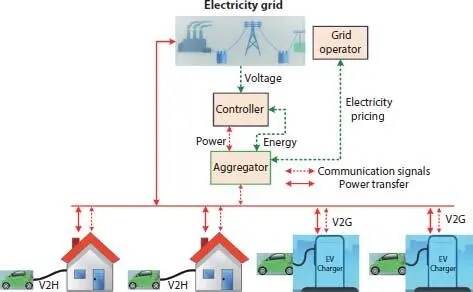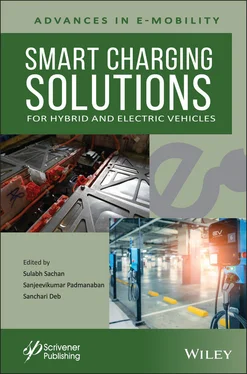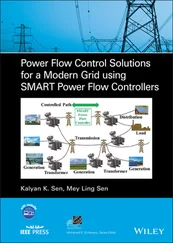Smart Charging Solutions for Hybrid and Electric Vehicles
Здесь есть возможность читать онлайн «Smart Charging Solutions for Hybrid and Electric Vehicles» — ознакомительный отрывок электронной книги совершенно бесплатно, а после прочтения отрывка купить полную версию. В некоторых случаях можно слушать аудио, скачать через торрент в формате fb2 и присутствует краткое содержание. Жанр: unrecognised, на английском языке. Описание произведения, (предисловие) а так же отзывы посетителей доступны на портале библиотеки ЛибКат.
- Название:Smart Charging Solutions for Hybrid and Electric Vehicles
- Автор:
- Жанр:
- Год:неизвестен
- ISBN:нет данных
- Рейтинг книги:4 / 5. Голосов: 1
-
Избранное:Добавить в избранное
- Отзывы:
-
Ваша оценка:
- 80
- 1
- 2
- 3
- 4
- 5
Smart Charging Solutions for Hybrid and Electric Vehicles: краткое содержание, описание и аннотация
Предлагаем к чтению аннотацию, описание, краткое содержание или предисловие (зависит от того, что написал сам автор книги «Smart Charging Solutions for Hybrid and Electric Vehicles»). Если вы не нашли необходимую информацию о книге — напишите в комментариях, мы постараемся отыскать её.
The most comprehensive and up-to-date study of smart charging solutions for hybrid and electric vehicles for engineers, scientists, students, and other professionals. Smart Charging Solutions for Hybrid and Electric Vehicles:
Smart Charging Solutions for Hybrid and Electric Vehicles — читать онлайн ознакомительный отрывок
Ниже представлен текст книги, разбитый по страницам. Система сохранения места последней прочитанной страницы, позволяет с удобством читать онлайн бесплатно книгу «Smart Charging Solutions for Hybrid and Electric Vehicles», без необходимости каждый раз заново искать на чём Вы остановились. Поставьте закладку, и сможете в любой момент перейти на страницу, на которой закончили чтение.
Интервал:
Закладка:
The direction of the flow of power plays a significant role in determining the impact of smart charging. In the case of charging, two types of viz., unidirectional and bidirectional, are described in the literature. In the case of unidirectional, there is a controlled power flow from the utility grid to the EVs to charge, while in bidirectional the power flow is exchanged between EVs and the utility grid [3, 5, 23, 24, 28-31]. When the grid is in peak load hours, controlled power flow from EVs to the utility grid meets the surplus demand and while during off-peak hours, the EVs charge using surplus power in the grid. Note that the charging process is spread out over the day and mostly controlled using algorithms. Of the two, the bidirectional flow of power is found to be better in reducing the impact of uncoordinated charging. A study by the International Renewable Energy Agency (IRENA) states that, in the short term, bidirectional smart charging is able to reduce more curtailment when compared to unidirectional smart charging [32].
Further, CO 2emissions are also reduced more in the bidirectional case, compared to the unidirectional. The long-term analysis by IRENA is done considering renewables’ integration, which includes solar and wind-based isolated systems. For the long-term, a reduction in CO 2is noticeable in bidirectional viz. when power renewables augment power production as compared to unidirectional. Hence, smart charging promotes the integration of renewables [27, 32].
The impact of smart charging is not limited to supporting the integration renewables, it also helps reduce stress on various equipment in the utility grid’s infrastructure. The impact is widely discussed in the subsequent subsections.
1.3.1 On the Grid Side
Smart charging’s grid-side infrastructure consists of transmission lines, transformers, substations, connected loads, and the PSO. Uncoordinated charging is widely discussed for various negative impacts it superimposes on the utility grid, such as components (transmission lines, transformers) overloading, power loss, voltage and frequency instability, and increased peak demand [24, 31]. With an increase in load due to the charging of EVs, the utility grid’s existing components are overloaded, which increases the demand for generation and transmission. The lifespan of all the components is adversely affected. Increased demand for active power leads to an increase in power loss in the distribution system [23-25]. Further, the financial losses incurred due to the components’ damage are mostly not reported in the literature, however, the PSO suffers huge losses due to added investment capital.
Subsection 2.3 described the goals of smart charging. Each goal finds a way to reduce the negative impacts mentioned in the previous paragraph. Smart charging has added the functionality of power management and renewable energy integration. The scheduling of the charging and discharging of EVs over the whole day optimizes power exchange between EVs and the utility grid. Peak load demand is met by using EVs as an energy source. Further, renewable energy’s intermittency is curbed by using EVs as energy storage or for charging using renewables. Added benefits of smart charging are the regulation of voltage (by absorbing and supplying reactive power) and frequency (by the exchange of active power), peak shaving and valley filling, and improved utility grid stability [33-35].
1.3.2 On the Demand Side
The demand side comprises of different types of load: residential, commercial, and industrial. The connected loads are vulnerable to power quality changes. The power quality parameters are defined based on voltage and frequency changes and the harmonics in the power supply [31, 36, 37]. With the integration of renewables and EVs in the system, a balance in the whole power system’s flow is achieved. Balance reduces voltage surges caused due to surplus power during off-peak load hours and uncoordinated addition of renewables or energy storage. Voltage flickers that damage various equipment, especially in the residential sector, are smoothed. The harmonics are reduced with added control and optimization techniques for smart charging. Power flow management and distribution constrains the phase imbalance on the demand side [38, 39]. Thus, consumers’ reliability, on the demand side, is weighted with loads of added benefits from smart charging.
1.3.3 Overall Infrastructure
The infrastructure of the existing utility grid is dominated by outdated equipment to monitor and operate. The implementation of smart charging requires robust communication, controller, and fault tracking systems. A possible solution to meet robustness requires using data-rich monitoring systems to perform necessary forecasting and optimization. Another possibility is upgrading the utility grid by replacing current components with smart components. For example, the conventional transformer can be replaced by a smart transformer. Conventional monitoring systems in substations can be replaced with high-performance systems that can perform monitoring, forecasting, and real-time computation of necessary parameters for fault detection, prevention, and correction. Upgrading the utility grid adds a financial burden to the PSO. Further, renewables integration to the utility grid helps reduce capital expenditure spent on increasing generation [40-43], hence, the PSO prefers to add precision sensors, communication systems, and data storage devices to upgrade rather than replacing the components.
The possibilities of changing infrastructure are immense. Every addition or upgrade to implement smart charging will help make the utility grid infrastructure smart, thereby improving reliability and stability and helping the PSO perform necessary day ahead or month ahead planning to reduce losses, both power and financial.
1.4 Types of Smart Charging
Smart charging is categorized based on the direction of flow of power: unidirectional or bidirectional. Smart unidirectional charging of EVs is implemented in conjunction with the ToU. EV users are encouraged to charge during off-peak load hours. The implementation of unidirectional smart charging is simple and requires the least technically advanced upgrades of existing components but proves to be effective in reducing uncoordinated charging. Further, the charging rate (slow, medium, or fast) in unidirectional charging is also monitored and controlled.
Bidirectional charging is called a “vehicle to everything” or V2X. The V2X is implemented in two standard configurations (shown in the schematic presented in Figure 1.3).

Figure 1.3 A schematic to differentiate V2H/V2B and V2G.
1 i. Vehicle to the Building (V2B) or Vehicle to Home (V2H): EV users park EVs in the home, hence, V2B/V2H is prominently used and is a preferred option. The EVs are charged from the supply from the utility grid or a local energy storage device (ESS). The local ESS has energy stored from any renewable energy sources or when the utility grid is in off-peak hours. An additional benefit of V2H/V2B is the use of EV batteries for residential power backup during utility grid outage periods. Further, the simplicity in operation, direct benefits provided to EV users on deploying V2B/V2H, and technology maturity have attracted the market [9, 10, 35, 44].
2 ii. Vehicle to Grid (V2G): In V2H/V2B, EVs are used as a residential power backup. However, when the EVs are used to provide support to the grid by discharging during peak load hours and charging during off-peak load hours, it is called V2G. V2G renders a noticeable impact on the grid’s operation compared to V2H/V2B [45, 46]. V2G requires intelligent controllers to provide ancillary services such as voltage and frequency control and secondary power reserve. The ToU is also implemented in conjunction with V2G systems [47]. The complexity in the implementation of V2G is higher than V2B/V2H and the technology requires mature and sophisticated solutions to draw market attention.
Читать дальшеИнтервал:
Закладка:
Похожие книги на «Smart Charging Solutions for Hybrid and Electric Vehicles»
Представляем Вашему вниманию похожие книги на «Smart Charging Solutions for Hybrid and Electric Vehicles» списком для выбора. Мы отобрали схожую по названию и смыслу литературу в надежде предоставить читателям больше вариантов отыскать новые, интересные, ещё непрочитанные произведения.
Обсуждение, отзывы о книге «Smart Charging Solutions for Hybrid and Electric Vehicles» и просто собственные мнения читателей. Оставьте ваши комментарии, напишите, что Вы думаете о произведении, его смысле или главных героях. Укажите что конкретно понравилось, а что нет, и почему Вы так считаете.












